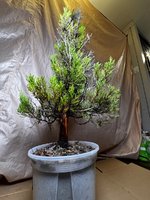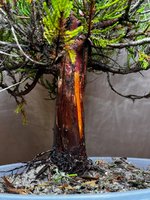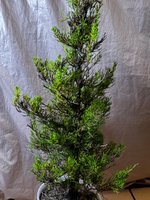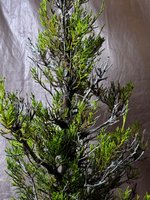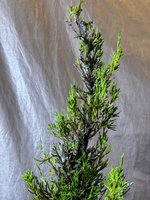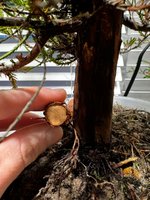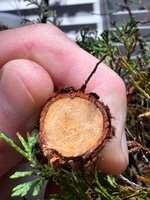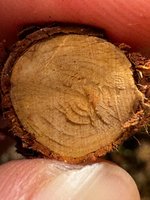NJtsr95
Seedling
In a quandary of how to proceed with this beautiful Yamadori ERC. It is 30” tall, trunk base 1.75” wide and fairly good proportions for a formal upright in the style of a giant Redwood?? I wont even dare to bother trying to wire the trunk; the taproot was like trying to cut through a steel cable, I preserved the upper 8” because of some strong laterals i didnt damage, which is why its in such a deep nursery pot, and while many of the fine feeder roots are in tact im not sure if i caused them mechanical damage during transplant.
Anyone know what could cause this exteme variation in foliage? It stuck out to me at first from far away, I couldnt tell what it was. It doesnt look like any ERC I’ve ever seen. I cant wait to try propagating to see if I can get clones of this beautiful foliage or if it was strictly as a result of the conditions grown in? Or if its genetically different? Just cant stop being enamored by it honestly and having trouble deciding what to do. I dont want to prune much because it looks nice as is, I dont want to stress the tree. But I want to get some healthy cuttings out of it in case the tree dies as its considerably older than I thought given the height and honestly surprised myself when i saw the thickness of the trunk and taproot.
wiring the branches will be “fun” but good practice. Am going to clean out some of the years of debris, prickly and dead scale foliage accumulated in the extremely dense branchlet crotches. Figure if i can wire this one without setting the tree on fire i can wire anything. The dodge a wrench approach as it is.
Advice welcome! (Tree inside to get better photos only)
Anyone know what could cause this exteme variation in foliage? It stuck out to me at first from far away, I couldnt tell what it was. It doesnt look like any ERC I’ve ever seen. I cant wait to try propagating to see if I can get clones of this beautiful foliage or if it was strictly as a result of the conditions grown in? Or if its genetically different? Just cant stop being enamored by it honestly and having trouble deciding what to do. I dont want to prune much because it looks nice as is, I dont want to stress the tree. But I want to get some healthy cuttings out of it in case the tree dies as its considerably older than I thought given the height and honestly surprised myself when i saw the thickness of the trunk and taproot.
wiring the branches will be “fun” but good practice. Am going to clean out some of the years of debris, prickly and dead scale foliage accumulated in the extremely dense branchlet crotches. Figure if i can wire this one without setting the tree on fire i can wire anything. The dodge a wrench approach as it is.
Advice welcome! (Tree inside to get better photos only)

